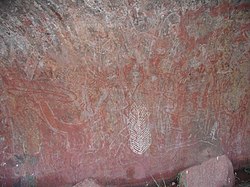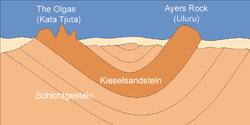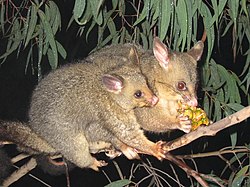Uluṟu–Kata Tjuṯa Aboriginal Land Trust
Uluṟu–Kata Tjuṯa Aboriginal Land Trust is the land trust that holds the freehold title to the land of Uluṟu–Kata Tjuṯa National Park (referred to as Northern Territory Portion 1728). The trust is the legal landowner and holds the title on behalf of the people who are recognised as the land's traditional owners. It was created on 26 October 1985.[1]
The land was originally claimed as part of the Katiti Land Claim in 1979.[2] It was sumbitted by the Central Land Council on the behalf of several hundred people, most of whom lived at Muṯitjulu.[3] The claim was judged in 1980, and Commissioner Justice John Toohey formally recognised 104 traditional owners for Uluṟu and 57 for Kata Tjuṯa.[2] He granted them freehold title to the land now held by the Katiti Aboriginal Land Trust. They were not granted the title to Uluṟu–Kata Tjuṯa because it was already being used as a national park.[3][4]
There was then a long legal case over the freehold title (actual ownership) of the park lands. The case continued until November 1983, when Prime Minister Bob Hawke acknowledged that the traditional owners had the rights to Uluṟu. In 1985, the Territory passed two amendments: one for the Aboriginal Land Rights Act and one for the National Parks and Wildlife Conservation Act. The freehold title to the land in the park was passed to the Uluṟu–Kata Tjuṯa Aboriginal Land Trust on 26 October 1985.[5] As part of the agreement, the land was immediately leased back to the Director of National Parks for a period of 99 years. The title is inalienable, which means that it can not be sold, traded or given away; it is inherited continuously by the community's descendants.
Uluṟu–Kata Tjuṯa Aboriginal Land Trust Media
Geologic cross-section of the national park. This image presents dubious facts, compare Website of www.environment.gov.au "Formation of Uluru-Kata Tjuta" see also Talk:"Geological Formation"
Bush tucker (bush foods) harvested at Alice Springs Desert Park.
References
- ↑ Uluru - Kata Tjuta National Park. "Return of the land to traditional owners". Learnline. Charles Darwin University. Archived from the original on 12 January 2013. Retrieved 17 April 2013.
- ↑ 2.0 2.1 "Uluṟu-Kata Tjuṯa National Park Notes: Non-Aboriginal history". Parks Australia and the Muṯitjulu Community. 19 October 2001.
- ↑ 3.0 3.1 Dawn Chatty; Marcus Colchester (2002), Conservation and mobile indigenous peoples: displacement, forced settlement, and sustainable development, Berghahn Books, p. 366–367, ISBN 978-1-57181-841-6
- ↑ Margo Neale; Sylvia Kleinert and Robyne Bancroft (2000). The Oxford companion to aboriginal art and culture. Oxford University Press. p. 54. ISBN 978-0-1955-0649-5.
- ↑ "Park history: Development of Aboriginal ownership and joint management". Australian Government, Department of Sustainability, Environment, Water, Population and Communities. Archived from the original on 29 February 2012. Retrieved 10 March 2012.
Other websites
- Uluru - Kata Tjuta Aboriginal Land Trust Archived 2013-04-18 at the Wayback Machine at the Agreements, Treaties and Negotiated Settlements Project, University of Melbourne









